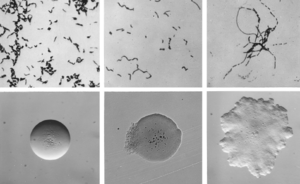Erysipelothrix
| Erysipelothrix | |
|---|---|
 | |
| Cellular and colonial morphology of Erysipelothrix rhusiopathiae | |
| Scientific classification | |
| Kingdom: | Bacteria |
| Phylum: | Firmicutes |
| Class: | Erysipelotrichi |
| Order: | Erysipelotrichales |
| Family: | Erysipelotrichidae |
| Genus: | Erysipelothrix |
| Species | |
|
Erysipelothrix rhusiopathiae | |
Erysipelothrix is a genus of bacteria containing four species.[1][2] "The hallmark of Erysipelothrix is the presence of a type B cell wall, in which the peptide bridge is formed between amino acids at positions 2 and 4 of adjacent peptide side-chains and not, as in the vast majority of bacteria, between amino acids at positions 3 and 4."[2]
The best known species is Erysipelothrix rhusiopathiae, which causes erysipelas of swine and other animal diseases. The other two species are apparently not pathogenic.[2] E. tonsillarum was described in 1987.[3] E. inopinata was described in 2004. These two species have been isolated from the tonsils of healthy pigs.[2] The new family Erysipelotrichidae was erected to contain this genus.[2]
These bacteria are Gram-positive. They can be mistaken for Gram-negative bacteria during analysis because they lose their staining easily. They are not acid-fast. They are slender, nonmotile rod-shaped bacteria. They are straight or slightly curved and can appear long and filamentous. They exist singly, in V-shaped pairs, or in short chains. They are aerobic to facultatively anaerobic.[4]
References
- 1 2 Parte, A.C. "Erysipelothrix". www.bacterio.net.
- 1 2 3 4 5 Verbarg, S., et al. (2004). Erysipelothrix inopinata sp. nov., isolated in the course of sterile filtration of vegetable peptone broth, and description of Erysipelotrichaceae fam. nov. IJSEM 54(1) 221-25.
- ↑ Takahashi, T., et al. (1987). Erysipelothrix tonsillarum sp. nov. isolated from tonsils of apparently healthy pigs. IJSB 37(2) 166-68.
- ↑ Stackebrandt, E., et al. (2006). The Genus Erysipelothrix. Prokaryotes 4 492-510.